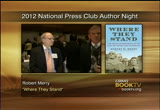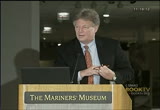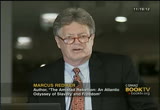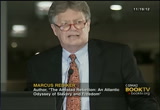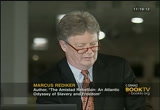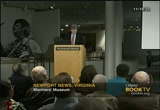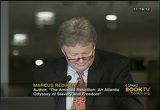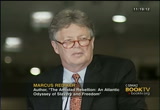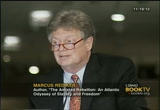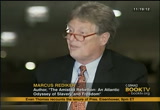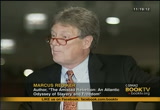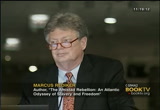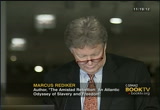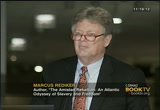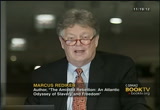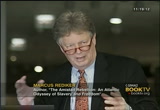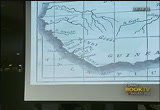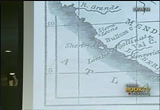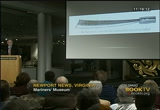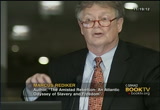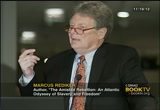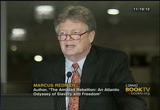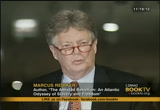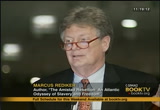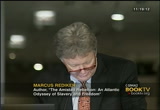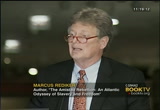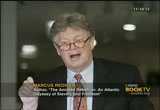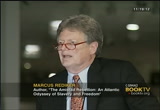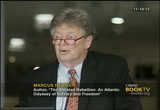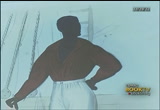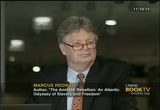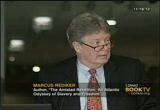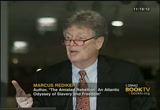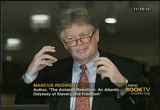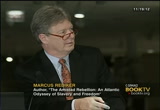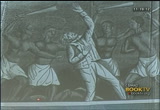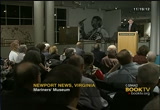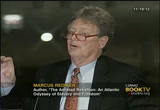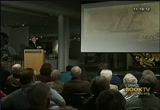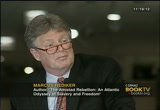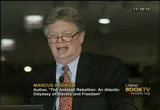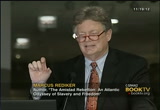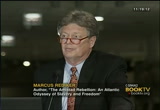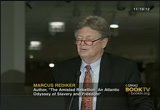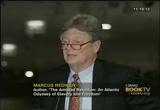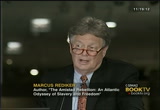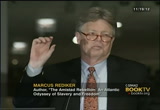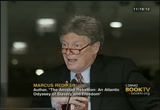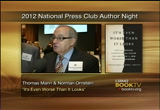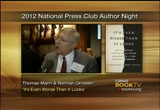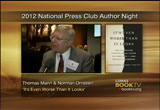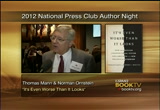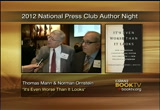tv Book TV CSPAN December 22, 2012 7:45pm-9:00pm EST
7:45 pm
if you would like to see a longer version of robert merry talking about his book, go to booktv.org. type in the search box, robert merry. you can watch the full program. >> next, slavery in 1839. the author reports 40s after the chipset sale, the captain was killed and the man aboard was sent to prison in connecticut where they awaited a trial heard by the sprinkler. the case was defended by john quincy adams and resulted in the release and return to africa. this is a little over one hour. >> greetings, everyone.
7:46 pm
i would like to begin with a very warm thanks to brian. there is brian back there. he has done so much to make this happen. also, thank you to emma for the generous introduction. and also we should give a round of applause the staff of this museum's maritime heritage, who keeps his heritage alive. [applause] now, i'm very happy to have a chance to talk with you this evening about a part of that heritage, which is not only concluding america's history. i want to talk to you about this book that i have written, "the amistad rebellion." i want to begin by reminding everybody just what happened in that story. okay? does let me summarize what happened. the year is 1839.
7:47 pm
this sleek schooner, la amistad, which in spanish means friendship. it contains 53 enslaved africans. men and children, including three little girls. they are being carried from hosanna to another part of cuba where the sugar plantation system is just exploding. sugar was a key the key to cuba as one of the most dynamic way societies in the world. they are on their way of only about 300 miles of coastal voyage. during the voyage, a revolt at sea takes place. the amistad people stand up, and
7:48 pm
they kill a captain. and they take control of the ship with the idea of sailing back to their african homeland, which is sierra leone. they all come from southern sierra leone. they keep to of the cubans alive. these were actually their so-called owners. it turns out that montes had been a ship captain. so he knew navigation. they told him to sail towards the rising sun. because the rising sun had been at their backs when they made the middle passage across the atlantic in the first place. well, montes was a clever man. during the day, he sailed to the east as he was constructed. but he kept the sales loose ends flapping in the wind, not to make much progress. at night, he reversed course and
7:49 pm
headed back towards the caribbean and north american coast, in the hope that he would be discovered. and they would be captured. that he and his fellow cuban slaveowners would be saved. so he checked the amistad africans. eventually, they saw that lacking food and water, they were not going to be able to make a long voyage. so it was asked by montes, do you want me to take you to a free country? they said, what free country is this? and they said that free country is the united states. well, you're talking about one of the leading free slave societies in the world at that time. not a free country. but the africans actually sail the vessel all the way up to the northern end of long island.
7:50 pm
they were taken by a u.s. navy ship, carried to new london, connecticut, and they were thrown in jail. they were charged with murder and piracy. now, as soon as word got out that these africans had come ashore, abolitionists from up and down the eastern coast flocked to the jail to try to assist them. again that this cause might help them to advance their struggle against the institution of slavery. well, a long legal battle took place. for 19 months, the amistad africans were in jail. they did receive support from no less a person than john quincy adams. former president at that time, he was a congressman who represented the 36 survivors for
7:51 pm
the united states supreme court and won a dramatic victory. declaring them illegally enslaved and therefore free, enabling them to return to their native land. which they did a month later in november of 1841. he returned to southern sierra leone, taking with them a group of missionaries. this is the organization of the american missionary association. they created the monday mission. we have an image of the ship itself? well, the amistad, in the moment it depicts, is a meeting with a group of white hunters on the northern end of long island. you can actually see them here. yes, this is the amistad. in the background, this is the naval vessel.
7:52 pm
it is on the way capture. this probably produced by an abolitionist artist. sometime after the actual board. so what we have here is a very important case in the struggle against slavery. important because it was a victory. this kind of thing was not common. the institution of slavery was extremely strong. abolitionists and enslaved africans won a significant victory in the case. okay, so the subject has been much study. it has been well studied. you may be wondering why write a new book about it. well, my interest in this particular case grew out of the previous book that i wrote. entitled the slave ship, in human history. this was published in 2007. this was a pretty gruesome subject of study area very
7:53 pm
painful. painful to see what was done to so many millions of africans into profits. the terror that was crucial to the management of people for these vessels. i really had to live with this for several years while writing this book. as i studied the slave ship, what i found is that there were a great many rebellions that rose up under the most extreme circumstances. he was really quite inspiring to see. if these people kept fighting back no matter what. even when they had almost no chance of success. many rebellions, very few successful rebellions. so in the back of my mind, the amistad case. why was this one successful?
7:54 pm
i really wanted to know. this was an extraordinary point to gruesome history. he captured my imagination. so i began to read about the amistad. one of hundreds of slave revolts on board the ship. one of the very few that actually achieve victory. what i found it bothered me. it was very good scholarship on the case, but almost all about the legal struggle. very few people have actually studied the revolt. very few people have actually wondered why it was successful in the first place. so it seemed to me that something important had been lost. it also seemed to me that in the
7:55 pm
process, the real heroes in the case, by that i mean the africans who risk their lives to gain freedom, they have been pushed aside. politicians and judges and abolitionists had become the main players in the story. john quincy adams, featured here are, we think of him as a kind of iconic hero. and i must tell you that he played an extremely important role. but nothing happened we know without the actions of this man. it was the actions that set everything else in motion.
7:56 pm
so returning to that. i want to return to that. i also wanted to question what seemed seem to me was one of the main arguments about this case. and that was that it was a great success story about the american legal system you fact that the supreme court could rule in their favor prove that the american legal system was the hero of the case alongside john quincy adams. to which i ask, do you mean the same legal system that was only 2.5 million people in bondage? at that moment. that is the hero of the story. i don't think so. i think we have to go back and look at the rebellion itself, especially looking at those africans who made the rebellion. so what we have here in both history and film is actually very good history from above.
7:57 pm
history that stresses the likes of john quincy adams. what i wanted to do was write a different kind of history. what you call history from below. whose history is a? was rebellion was a? what does it mean to us now? those are questions that i wanted to post. well, in the course of doing this research, i must tell you that this project is full of surprises. it is a story that everyone thinks that they know. and i thought that i probably knew it too. it turns out that there were so many surprises. this actually put me in mind of the phrase formed by a very eminent american historian. lawrence talks about the unpredictable past. it is a great phrase. the past of the amistad was
7:58 pm
extremely unpredictable. what i have to share with you today are some of the surprises. over the surprises of doing this kind of resort? diversifies them in some ways the biggest surprise of doing this research and the one that made many a sequence of bytes as possible had to do it the quantity and quality of evidence about the africans who made the revolt. now, i have spent 30 years studying sailors, enslaved africans, or people who left almost no documents of their own. so i was trained to do this kind of work. to try to write history from below. people who had been left out of most of the historical
7:59 pm
narratives. but i must tell you that the body of evidence available about this case, i am convinced is the richest and deepest of any i have ever seen about any group of enslaved rebels anywhere. it's a staggering body of evidence. let me give you a few examples. when i came to study the rebellion itself, i wondered, are their first-person accounts of a? it turns out there are more than 70 first-person accounts of it. told by 17 different people. sailors, cuban slaveowners, one afro-cuban sailor in 12 of the amistad africans told their version of what happened in that rebellion. some of them told it more than once. they told it at varying lengths to 70 counts.
8:00 pm
8:01 pm
more about that in a moment. but these people who came into the jailed, they had -- did remarkable. some of them drew portraits. these were sketched by a 17-year-old artist named william townsend. these are two of the very important players in all of this. this man here was probably the second most important figure among the amistad africans second as a leader. he was a very important figure in his native society in west africa. and here is one of the children, a little girl. she was about nine years old. sheet too will play a significant role in this entire case. and more about that in a moment as well.
8:02 pm
so, artist or other pictures. correspondence conduct interviews. people write about the amistad articles and letters. people publish letters about the amistad africans in their newspapers. what this means is that there are a great many very detailed sources about who these people were and what their lives were like. and now let me just mention two other sets of sources which i found which proved to be especially important. i found a series of letters written by the teacher of the amistad africans. one of the things that happened was the jail became a school room and people learned. they learned english. they learned arithmetic. they studied christianity. this was very important to the
8:03 pm
to the abolitionist that they be taught the rudiments of christianity. so this teacher, young man named samuel was an undergraduate student at yale university. he spent many hours each day with the amistad africans and in the period running up to their departure to go back to africa, he starts talking to them and tentatively about where they live and who they were and what their lives were like back in africa, because that informatiinformati on was going to be crucial to getting them back home. he wrote a series of letters about this, some of them published and small abolitionist publications. but they are full of rich detail about the african lives of these people. that is one very important set of sources and then there was another, and this you have to say is a scholar's dream. we spend folks a lot of time
8:04 pm
showing up in archives and looking for the source in that source and bat wing burned down in 1916 and we don't have the sources anymore, sorry that is all gone. well, in 1852, 13 years after the rebellion, a young woman named hanna went from the united states to work with the mission in sierra leone and at a holiday dinner where there were still i think maybe four or five of the amistad veterans living at the mission, she asked them to tell their story of the uprising. and then she wrote it all down. so she transcribed their oral history of the rebellion and how they had committed it into their own memory. this is a stunning source and it contains information that no
8:05 pm
other other source of the time period has. for example, about what was the debate down in the amistad when they are trying to decide to rise up. the oral history contained information about that discussion. that is really getting close to the source. you actually hear the voices of the people who made history. so, my point is, there is a huge amount of evidence or history from below, so much so that it's possible actually to get to know these people as individuals. you could hear them speaking. you can get a sense of their sense of humor. it's a really intimate body of sources. that's the first surprise.
8:06 pm
the second surprise is not really a surprise but it's the utter centrality of africa to this entire story. i wanted to pose the question, what is the big story here, not just what happened in that courtroom but what is the big story? well, guess what? the big story is the story about slavery and freedom and it begins in southern sierra leone. my account begins by asking a very simple question. who were these people? who were the people and what were their lives like before they were enslaved? who were they? well, they were first of all a motley crew that reached 10 different african ethnicities or nationalities.
8:07 pm
they spoke probably 15 different languages among themselves. the largest group among them was called the mende. this in fact is the largest culture group in southern sierra leone. about two-thirds of the amistad africans were mende and then there were three or four of other groups, including the tempeh, the co-know and then one or two people from other groups. these are basically the main culture groups of southern sierra leone. but one thing i noticed was that they had an unusual complicity to communicate with each other. slave traders would frequently mix the ethnicities and nationalities of the people, the human cargo, so as to prevent their cooperation. that did not happen in this instance because many people could speak mende and many of the non-mende could also.
8:08 pm
>> mende. so there is that and then there is the multilingual reality in which many of these people can speak three, four in five languages. they were in a position to communicate with each other. this is a very important fact in making the revolt on the slave ship. i will just give you an idea of where they came from. you will see we have got free town where the british have set up their own colony of sorts. here is the american colony of liberia, where some people of african descent were being repatriated and here is what is called the elitist coast. mocha was the name of the slave trade fortress where the amistad were shipped out in few of the mende further in and the ukel him closer to the coast.
8:09 pm
this basically is the region where almost all of them came from. now, what kind of experiences did they have? it turns out one of the most important things that all of the men, all 49 of the men had in common word that they were trained warriors. it turns out that southern sierra leone in the 18 30s was wracked by warfare primarily because this group called the fly in tandem with its banished slave traders in this region had gone into the interior making war and capturing people to bring them back to the coast to sell. to be transported to places like cuba and brazil especially. so, understanding that these
8:10 pm
people were warriors helps you to see why they might have been successful in carrying off this rebellion and it actually proves to be a very important fact. this is the image of the tempeh warrior ,-com,-com ma the same period. a warrior with poison arrows. i show you this image because the band around his neck has what's called a -- bag that they frequently wore that contained spiritually charged substances that would protect the warrior in battle. and just to give you an example of how this operated, one eyewitness said that he walked into court one day with a box on a ribbon. that person had no idea. he didn't know that this was a
8:11 pm
protective power of the warrior. but that is the way it played out. now for the mendi, the weapon of choice was not the bow and arrow. it was the compass. mendi warriors fought mostly with knives. so guess what they found on board the amistad? they found a box of machetes or cane knives. this must have seemed like a gift from the ancestors. mendi warriors were given knives? guess how they found them? one of the minor mysteries of the amistad case. it turns out that three little girls who were not chained and had freed movement around the ship, found the box of machetes and told them where they were. the little girls play very
8:12 pm
important role in the success of the revolt. now, going back to west africa for a moment. something that i learned about that i think being especially important was this. i wanted to know what were the experiences of self organization that the people on the amistad had? what were their models of self organization? what kinds of organization had they known in their native society? it turns out it was especially important. it was something called the porro society, an all-male secret society. there is an equivalent for women that is very prominent among the mendi but also prominent among the tempeh, all of the groups of southern sierra leone have their own society and what the society does his fundamental to the way in which those societies
8:13 pm
operate. the porro society trained warriors. the porro society creates social discipline and the porro society deals with witchcraft. the porro society declares war. they actually have a word or two words for the goal of the porro society and the way that it operates. his goal was to create literally one word meaning -- everybody agrees one word. we are unified in purpose. everybody is doing the same thing. there is that creation of social discipline. well, a lot about the mendi societies and the other societies, i learned a lot about the porro but i came up against
8:14 pm
a real dilemma and the dilemma is, anyone who is initiated into the porro is charged on pain of death, you must never reveal any of the secrets of its floor. so how am i going to prove the importance of the porro society as a means of self organization if nobody is ever going to mention that? now i was sure that with with the amistad would you have basically was a displaced porro society meeting and they are deciding whether to declare war on the members but i could not prove it. all around this time i couldn't prove it. wife and i found two pieces of information that convinced me it really was porro related. the self of these was written by a missionary with a return back to southern sierra leone. this was kind of the moment of
8:15 pm
truth because an african going ashore and there were many of their own people, mendi and others there to greet them, and what's the amistad africans began to do was to share their western culture. this really upset them. this was the reversion to heathenism. this was the reversion to barbarism. this was licentiousness. this was awful but it turns out that even they recognize something else was going on. they didn't take off those clothes simply to defy the missionaries. they did it in order to show their country marks. their ritual scarification set they had, which showed which ethnic national group they were a member of. this was very important when you come back to sierra leone. what they were showing where
8:16 pm
their poor old marks. the porro society over this scarification and suddenly at this moment the missionaries began at the first time to understand the importance of african cultural forums in one of them wrote, you know they are very important to them. they are very proud of them. they are badges of honor. they are part of their identity. no kidding? csc.'s, that's exactly who they were. finally they saw it, so you could see the role of the porro in people's identity at this crucial moment. then came a second piece of evidence. in that oral history, talking about the debate in the amistad, one of the people there said, he is not named -- who it was for.
8:17 pm
it turns out four of the men were not for war. so a debate broke out. and albert, and this is another part of north african society, the elders a very important figure. an old man stood up and basically addressed to those for men and said they were very likely to die. you want to die an honorable death? and they said yes, they would. at that point, the oral history says we had one word. and that one word was -- [inaudible] so they even use the english translation, one word. so again you see the porro society operating in the whole of the vessel. okay so this is a very important part of the african side of the story. the other thing that i thought was especially crucial was what happened in jail.
8:18 pm
our emphasis on the courtroom not only blinded as to the rebellion but also blinded us to what was happening in jail for 19 months. what was happening in jail was that you had african rebels and american abolitionists meeting face-to-face and trying to figure out how to call operate. this is a very important moment. i don't think anything quite like this has ever happened before. they have to build an alliance if they are going to effectively fight the institution of slavery. well, what i identified as the crucial process amongst the amistad africans was basically to go back to something that is frequently discussed in the slave trade and i talk about this point in my book on the slave ships. this term called fictive kinship meeting people who are not really related to each other
8:19 pm
create relationships and act as if they are really related. this was going on on the slave ships. old kinship systems have been shattered. they are creatively trying to build something new. this began at ft. lamoka. a continued on the first slave ship. this continued in cuba. this continued on the amistad and this continued in the jail and one of the most impressive things you will see is the way in which this group from multiethnic africa hold themselves together as a group. unified, always pushing for their single objective, which is they said it repeatedly -- we want to go home. their idea of freedom was to resume the lives they had in
8:20 pm
sierra leone before their enslavement. and then, about a year into their jail experience something new happened. i thought this was a remarkable too. they came up with a new name for themselves. they began to call themselves the mendi people. they were not all mendi. that they had heard people saying in jail, there is this powerful sovereign force called the american people. that is the source of all power in this republic, the american people. they said oh, you are the american people. we are the mendi people. we are eagles. american people, mendi people and they use this phrase the mendi people to make their political demands and even to instruct john quincy adams about what he was supposed to say to the great court when it came time for them to hear their case. so, my point here and this is
8:21 pm
the second big surprise, is that the african side of the story really matters in terms of how the rebellion happened and how these people organized themselves in jail. it makes a huge difference. the third surprise. the third surprise is basically this. nothing that i read about the amistad case prepared me to understand how tremendously popular it was. i have already mentioned those groups of people lining up and going through the jail. you know folks, tens of thousands of people did that. 4000 people alone on the first day they were in no new haven jails, 4000 people filed through there. it's extraordinary. but, what happened? artists come in.
8:22 pm
in. use awesome sketches. one man came in and took castings and then created 29 life sized wax figures of this imus dodd africans and assemble them at the moment of rebellion and charged admission for people to come see it. another artist chirla a panorama painting that was 135 feet long. folks, that's more than twice as long as the amistad itself was. they would roll it up into a giant campus and turn round and unroll it and charge admission. but it shows how fascinated people were in this case. they wanted to know everything about it. now, this is all in the context of the northern society. historians have now discovered it was quite racist. there were violent mob attacks on three black communities.
8:23 pm
there were violent mob attacks on abolitionists. there were violent mob attacks on inter-racial churches. so this popularity is remarkable alongside these other things that are very common in the 18 30s. well, one of the most remarkable aspects of this popular interest was that a newspaper called the new york sun -- this was penny press paper -- took a tremendous interest in this case. now the penny press you will need to know, was a new kind of newspaper meant for a broader part of the population. the old commercial newspapers were more expensive than they were usually bought by upper artisans, merchants and middle-class people and people involved in commerce but the penny press was basically for working people, especially in new york.
8:24 pm
so the editor of the new york sun sends not only correspondence to new london and the new haven, he also sends artists and i want to show you what one of them produce. now this is an amazing image. here is a pose of a heroic roman conqueror. with his machete in his hand. he is like an avenger of justice, is he not? you have got to put this into the context of most of the graphic representation of people of african descent in this period were racist in the extreme. so, this is a very different kind of image. the first time i saw that i thought my goodness, it must be some kind of underground radical abolitionist group.
8:25 pm
no, it's the new york sun. why did they do it? because they thought it would make money. and guess what? they did. they printed and reprinted and reprinted the images because people couldn't get enough of them. alongside this, the reporters are writing accounts of the rebellion that are very, very favorable, very positive. you might even say romantic. some of the earliest accounts are very elaborate descriptions of what a hero he is. this is really unusual. so my point here is that the amistad africans captured the imagination of popular culture. in a way that made their case extremely unusual. the degree of popular interest in the case i argue in this book
8:26 pm
had an impact on the legal decisions taken because at every step of the way, nobody thought that they were going to win any of these legal decisions and every judge ruled in their favor acknowledged the extraordinary popular interest in the case. how could they avoid it, because every time the amistad africans came to trial, the courtroom was, as one man put it, crowded to suffocation. there were so many people packed into that courtroom that no one would leave during break for fear of losing their seat. so the popularity of the case i think was very important to the outcome. finally, the biggest surprise of all. the biggest surprise of all is just how wildly improbable the
8:27 pm
whole thing is. think about it. this motley crew of 53 africans somewhere in the northern caribbean drop on their warrior skills and there've koro society background to launch a rebellion. that is remarkable in its own right. but the really wild part of it is, over the next two years, that action they took will cause the most powerful people in the world to debate the meaning of what they had done. the queen of spain, the raiders parliament, to united states presidents, supreme court justices, the american congress, the queen of england. they are all paying close attention to this debate.
8:28 pm
what do we do about these africans who have taken courage and hand and seized their own freedom? well, they are self emancipation i will suggest had a lot of ripple effects around the atlantic in europe, in and africa, the caribbean and in america, especially in america where it had the impact of radicalizing the abolitionist movement. and by that i mean that more and more people began to recognize that the resistance of enslaved people was crucial to abolition. it began during the time of the amos.rebellion and to quote the famous line from lord byron. this is repeated again and again and again all the way up to the civil war, and that line was, those who would be free must
8:29 pm
themselves strike the first blow. in other words, action from below can be a trigger. this had a very dramatic impact on a lot of leading african-american intellectuals like henry highland barnett, frederick douglass and it had a bit effect on a man named john brown who wanted to strike the first blow at harpers ferry. so i guess this is a final thought i would leave you with. one of the most remarkable things about movements from below is that they are unpredictable. you never know when they are going to arise or how. these things that rise up and demands for justice, these demands for equality, these demands for freedom. they are unpredictable and in
8:30 pm
their unpredictability i think they are also a great source of hope. thank you very much. [applause] we have time for questions and i hope you will have some. we would like you to speak into the microphone if possible. >> during the discussion you talk about roaming around. how did they believe that slaves are brought onto the ship and were shackled and stayed shackled. did they get free somehow? >> is a good question. the standard practice on slave ships was for the men to be shackled but not the women or children.
8:31 pm
a must the women resisted in which case they would be shackled by the men. but they were not usually shackled to a particular place. in other words, two men would be shackled at the wrist and at the ankle but then if they were going to move they had to coordinate their movements in order to get for example to what they call the necessary tubs on the lower deck. one reason why you had to be able to move around. you also have to be able to come up from below. the amistad africans were chained together in a large number. so one of the questions has always been, how did they manage to get out of their chains? well, i will tell you a fact about who they were as africans. two of them were blacksmiths. that will help if you are trying to get out of chains, to have
8:32 pm
the blacksmiths who were there so basically they managed to break the central padlock, to free themselves and that is what enabled them to come up on the deck to begin a rebellion. but you are right, there is a question about how did they actually get free. >> hi. i'm fascinated by this idea as -- as a trigger and i'm curious if you could discuss why you think the amistad rebellion captured the american imagination in a popular way when rebellions on plantations affected them in a negative way? >> that's a good question. did everybody here it? why was the amistad rebellion able to capture the imagination when for example nat turner's rebellion did not? there were no positive depictions of nat turner in the media as far as i can tell or anyone else can tell. okay, here is something about
8:33 pm
the imus.rebellion that made it safer for popular support. first of all, they were not african-american slaves. they were africans. that matters. secondly, the slave owners were not american slaveowners like john c. calhoun or others. they were cuban slaveholders. so that made it easier to vilify the cubans slaveholders. okay, so it's a little bit different. it's a little bit safer, but i would emphasize, that is not an easy distinction to maintain. in other words, i have never read about any american slaveowner who would have liked
8:34 pm
to see an image like that. [laughter] you don't glorify and lionize slave rebels. the spanish government pointed this out very clearly to the american. are you going to say that it's legal for these people to kill a white man, a figure of authority, and capture a ship? all of the slaves in america will be very interested to get this news. so there are contradictions there but i do believe the fact that it came from outside the united states into the united states made it a little easier. but the other thing which i think really does matter is that this was a really very dramatic event. and what has struck me about the popular side of it is that they were interested in who these people were as africans and there was some sort of exoticism
8:35 pm
in that. people of connecticut had never really seen africans before so that was part of it. but on the other hand, the rebellion itself was what they really wanted to know about. that is why the paintings -- this is actually an engraving done by a connecticut artist. it's kind of contradictory and interesting, isn't it? here you have the afro-cuban captain and here's the captain being killed by four men and actually that was after it was for warriors who surrounded him and killed him. here is the ship's -- who was already dead. here is jose luis so this is all done by people who would have been in the jail who knew who these africans were.
8:36 pm
you can recognize him. that's definitely him. this is a man named rob lowe. i'm sorry, that is kono. the fact that you could get close to the rebellion i think was very exciting. one thing i didn't mention is that six days after the amistad african came to shore in new london connecticut, play was being reformed in new york about their appraising. it only took six days and it was a hit. it was a hit in a theater that had a very large working-class audience, a black-and-white audience at the bowery theater. it was estimated thousands of people saw that plan they learned about the rebellion that way and he was a hero. all of the things are kind of counterintuitive, aren't they?
8:37 pm
that is part of why this project was so surprising. they did not expect to see this level of not only popular interest but a sympathy. a lot of people went to jail saying i hate the abolitionist but i really support those africans. those abolitionists are dangerous extremist but we support these people. we want those people to be free so it's interesting it expands the idea of anti-slavery the abolitionist. yes? >> yes, what happened to the slaveowners after they came ashore? >> yes, the slaveowners came ashore and what was very interesting is that there demands were quite simple, give us our slaves back. that there was a question raised from the very beginning that the slaves were not legal slaves
8:38 pm
because spain had signed a treaty with great britain promising not to import any new slaves after 1835. so the cuban slaveowners have very cleverly given the imus.africans spanish names to try to represent them as having been an an in culture rated on the island. they did not understand a word of spanish. so it's interesting to see. at the slaveholders stayed in connecticut, trying for a while to get their property back, their human property and then something dramatic happened. lewis chaplain, leading abolitionist once they found africans telling their side of the story lewis tap in the range to charge the slaveowners with violent assault based upon the beatings they had given these illegally enslaved people on
8:39 pm
board the ship so they both got slapped in jail. this was a pretty dramatic moment and especially in the south because they said well what happens to the southern master who -- his slave's? are you going to slap us in jail? that is why there was a bounty on lewis tappan's head. they eventually gave up is the short answer. they waged a battle and the queen of spain carried on requesting reimbursement for the slaves all the way up through the civil war. yes? >> what was the length of time from the time of the rebellion until they got to new york and also isn't the first time that anyone on board the ship was aware of the situation? >> yes, good question. the rebellion to place and they
8:40 pm
were there for about seven weeks before they got to the upper end of long island. now we know from the accounts of the boys that they stopped 30 times, mostly to get water. they didn't have enough water. we also know that the slaveowner and the one-hit new navigation wanted to take them to charleston south carolina. it would have been a different outcome. if they had gone to charlestcharlest on. but, here is something that is kind of revealing. when the imus.africans saw, and i will go back to this -- you see over here. when they came ashore, they were hungry, they were thirsty but when they saw these white men who were hunters, they did not
8:41 pm
ask for food. they did not ask for water. the first thing they said was, and this was man who could speak a few words of english. he said, is the slavery country? it was an interesting kind of political idea in some parts of this world where slavery countries and some parts weren't. had they gone ashore and asked that question in south carolina, i don't know. i don't have evidence that they did. they might have. but basically they had an idea that they had to give to a place in slavery country in order to have a chance to be free. i think they were right about it. so i think this is a very important fact about why they eventually one perk of the fact that they were able to sail the ship, about 1400 miles far enough north and he said yes, this is not slavery country. this is a free country. slavery was abolished in new
8:42 pm
york and they cheered in the exalted and they were really happy, so much so that they scared the white owners who went and got their guns. they said no, no, we are just happy. it was literally the case that they worked their way to freedom by sailing the ship and getting to a place where they had a chance for freedom. after that what matters is the alliance they build with the abolitionists while they are in jail. yes? >> yes, is there kind of a media backlash among the southern states trying to promote their own ideas in the popularity of the amistad in the north and does this lead to a lyrical ramification where they are really pointing to an the north and saying see, they are not on our side, they are not like us? >> it's a very good point and
8:43 pm
it's certainly true that the southern newspapers are very, very volatile ball -- not volatile and demanding that the africans be taken back to cuba immediately. they are unequivocally slave property and must be sent back. what's interesting about the media backlash is that it turns out the other major penny press papers, the new york morning herald published in new york just like the new york sun, is proslavery. so they also send correspondence and so you will frequently find the new york sun correspondence and the new york herald sun correspondence writing about events in radically different ways. the new york morning herald is absolutely appalled by the interest in this case. they are worse than paul.
8:44 pm
they are infuriated and they just scream bloody murder. those people that you are touting are just cold-blooded murderers. so there's said egg fierce debate and of course the fact that the debate goes on makes everyone else interested in the case. >> during the 19 months that they were jailed, how were the three little girls? was there any special attention given to them? >> yes, okay, i'm so glad you asked that question because i wanted to go back and show you what a difference the history makes it a story. i found a story in the newspaper about five days after they had moved to new haven where one man says, the three little girls were teaching several gentlemen how to count from one to 10 in their native language of the
8:45 pm
best idea he had he got from the three little girls. so they were in an unusual position and they were actually the source of considerable conflict between the amistad africans and with the jailer did was remove the three little girls to become his personal servants in his household. i can tell you they did not like it one bit. partly because it separated their -- they wanted to keep everybody together. there was nothing they could do about it because the jailer had power over the jail. eventually they began to complain because the three little girls for not learning to speak english as well as their little boy, their counterpoint, little boy named colin and they were blaming the jailer for not contributing to their education.
8:46 pm
whereupon the jailer and his wife made several racist comments about why would you want to try to educate them? so this became kind of part of attention. the little girls were put into a different category and then there was later on a battle over who should lead their proper -- who should be in charge of their lives basically and they were moved legally. the imus.africans in the abolitionists moved them from the household of the jailer and they wanted the abolitionists close to the africans. the question was, did they also go back to sierra leone? c.'s they get on all three of the girls remained with them for many years and margaret, right
8:47 pm
there. she actually came back to the united states and became the first black female graduate of -- college and went back to sierra leone as a missionary herself. most of the adult men were able to find their families and actually did what they wanted to do when they went back. they wanted to go back to their lives. there is a tragic counterpoint for sink it. when he got back he was searching for his wife and three children and discovered that the belichick been completely destroyed in the warfare that continued after his own enslavement. it is true that the larger reality of war and slave trade was beyond his ability to control it even though he did win one great victory, he lost
8:48 pm
his family. >> i had a question about the missionaries. you talked about how missionaries teach whether that or not they embrace christianity or not and i was interested in how well did the missionaries think they succeeded in converting these ends in what ways did the africans use it to further their own and? >> a good question, thank you. i think the missionaries, including the most religious of the abolitionists such as louis tappan, were properly realistic in saying that they knew that the amistad africans would study christianity that they did not think they had embraced it as a belief. maybe if you had, they hoped.
8:49 pm
maybe a few had, they hope it turns out this is an interesting and complex question because clearly the.africans recognized what was important to the abolitionists. and so their attitude was, if you want us to study your language in your religion, we will do it but at the same time we are going to insist on our own identity as the mendi people. so you could say that their african identity grew as a counterpoint to this idea that they should become civilized, pious christians. now, all of these tensions were on display because once the supreme court ruled in their favor, and said they could go home, well the supreme court also ruled that the united states government had no responsibility to pay for their going home so how are they going to get home? for the longest time people
8:50 pm
believe that louis tappan and some other wealthy abolitionists could pay for this but in fact what happened was, the abolitionists with the cooperation of the.africans organized to pick two or up and down the eastern seaboard in which the.africans would go and speak and perform, perform their knowledge of christianity, perform their knowledge of english, perform their civilization and at the same time, they would insist on singing their native african songs. the african side was always there and here is the wildest part of it all. the main it sent in every one of these performances, and they all by the way are formed before packed houses. i mean, the comment on these
8:51 pm
meetings were, we couldn't get any -- everyone in who wanted to see it. we were talking about churches that held two or 3000 people. the highlight of every offense was when senke arose to take the floor to tell the story and literally to act out the rebellion and he spoke only mendi. this was the way they were going to do it. and i can't tell you the number of people who come in and they say, he is one of the most powerful orators we have ever seen even though we couldn't understand a word he was saying. but in not understanding what he was saying, a different point was being made. we are mendi people. this is their language. we will speak in our language. this is our story. and that is what senke did and
8:52 pm
everyone of these meetings. he told his story in mendi. it's a fascinating thing to see how this matter of a christian identity and the african identity are linked. [applause] >> the thank you very much for coming out tonight. i would like to invite you back for a reception here and i'm sure he will come back to answer any further questions and sign books. thank you very much for coming. >> for more information visit the author's web site, marcus rediker.com.
8:54 pm
>> two familiar faces to regular c-span booktv watchers, norm ornstein and thomas mann. their most recent book, "it's even worse than it looks," how the american constitutional system collided with the new politics of extremism. mr. ornstein ,-com,-com ma very quickly, what's the premise of your book? >> first i have to say peter that we have been with c-span since the beginning and i have pictures of my office of not writing sessions on the fifth anniversary of c-span, which is a very long time ago. >> and i was on the panel. with a very young newt gingrich among others. >> very thin newt gingrich too but that's a different story. this is a the book really about the reality that in 43 years,
8:55 pm
two of us have been immersed in the politics of washington washington from one in the pennsylvania avenue to the other, we have never seen it this dysfunctional. the dysfunction is that a critical mass and we felt we had to speak out about how the problem is and is the book says even worse than it looks. it never looks good and we have to talk about who is at fault in what we can do to get out of it. half the book is about how we been get out of this mess. >> the argument basically is twofold. one, we have now polarized political parties. internally, homogeneous, very much at loggerheads, much like elementary parties, the eminently oppositional. they have to work in a constitutional system based on separation of powers and checks and balances. the mismatch between our parties
8:56 pm
and our governing institutions is problem number one. problem number two, which is the toughest thing for us to say, and for many people to hear, is that the parties are not equally implicated in this. we have something called asymmetric polarization in which the republican party has in recent years become almost a radical insurgency, quite prepared to repeal 100 years worth of public policy. so, we don't know how to cope with the situation when both of our parties are not operating in the mainstream and the book is written to help people understand why this has happened and what we can do about about it. >> now wasn't there a time though that the democrats were the party that was asymmetrically out of balance with the rest of the nation?
8:57 pm
>> oh yeah and that it's been true many times in history. most recently in the 1960's, you know, vietnam and other issues and going back to the 1890s which was the last period of time attic polarization like this when the democrats were off the rails on the left. you know we come out of these terrible problems but it can take a decade or more and we don't think we have a decade or more so there's a sense of urgency and the oneness frankly that has not been characteristic of a lot of our work that we feel is necessary. >> thomas mann did the 2012 elections clarify anything? >> by all appearances, it was a status quo election. returning us to the division of power, obama and the white house, democrats in control of the senate and republicans in the house. but appearances can be deceiving and in this case they are.
8:58 pm
the most important reality of the election is that the republican effort to oppose anything and everything proposed by obama, almost like the parliamentary party, was not rewarding and taking the debt ceiling hostage was not rewarded. calling the obama health care plan, which was their own only a few years earlier, socialism was not reported. that means they have to begin to rethink themselves and importantly, democrats will not automatically embrace the same tactics in opposition, so i think that was an important change that creates a new dynamic, not that it's going to solve our problems. there's going to be no sitting around the camp liar and washington making nice to one
8:59 pm
another, but the possibility now exists for a real effort and a successful effort to deal with our most pressing problems. >> two familiar washington faces, thomas mann and norm ornstein. "it's even worse than it looks." this is booktv on c-span2. >> you don't always find many newspaper editors in any era embracing investigative reporting. the point is, it's not just economics, it's the discomfort that investigative reporting causes in the newsroom. it's that more than the economics. if you are going to ruffle the feathers of somebody powerful that gets those people running into complaint to the publisher and their stories are overviews about those and we were fortunate in the 70's and really through almost all of our careers to work for people who are really strong and
774 Views
IN COLLECTIONS
CSPAN2 Television Archive
Television Archive  Television Archive News Search Service
Television Archive News Search Service 
Uploaded by TV Archive on

 Live Music Archive
Live Music Archive Librivox Free Audio
Librivox Free Audio Metropolitan Museum
Metropolitan Museum Cleveland Museum of Art
Cleveland Museum of Art Internet Arcade
Internet Arcade Console Living Room
Console Living Room Books to Borrow
Books to Borrow Open Library
Open Library TV News
TV News Understanding 9/11
Understanding 9/11